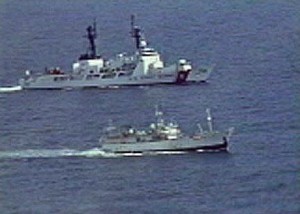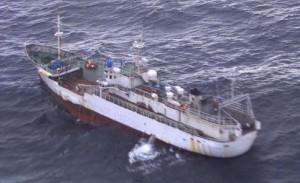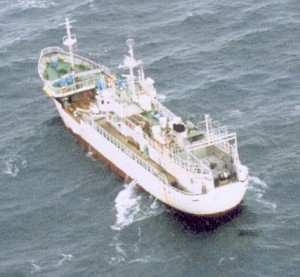PIRATE DRIFTNET BOAT CAUGHT BY THE U.S. COAST GUARD
EARTHTRUST PRESS RELEASE
The Arctic Wind, a classic high seas driftnet boat was apprehended and boarded by a team from the United States Coast Guard cutter Sherman, on May 8, 2000. The vessel was first seen 600 miles from Adak, Alaska.
The Sherman had been joined in its pursuit of the vessel by a Coast Guard patrol boat out of Adak. After a 5-day chase, the vessel was boarded but not until after a high seas drama was played out. The vessel had been attempting to “stripmine” the seas of salmon and sail back to the East with its booty undetected. But the sharp eyes of the Coast Guard spotted the telltale signs of a high seas driftnetter and sprung into action. The boat, once detected, sought to escape apprehension by leading the CG in a convoluted chase across the open seas. It did not stop until Cpt. David Ryan received permission to fire on the boat, uncovered his guns and turned them towards the vessel ready to fire warning shots at the surprised and heretofore cocky crew.
Earthtrust salutes the Coast Guard for its ” get tough ” attitude. This was the first time that the Coast Guard had authorization to use warning shots to stop a driftnet boat that was running away. The Russian crew aboard had apparently overlooked that the use of warning shots had been used successfully by a Russian enforcement boat in a prior driftnet season and didn’t believe the U.S. had the moxy to do the same. They were wrong.

The Arctic Wind high seas driftnet boat attempting to outrun the U.S. Coast Guard. May 2000. Credit: U.S Coast Guard.
By apprehending this boat, the Coast Guard prevented the destruction of much marine life. The driftnet season begins in earnest in April/May in the North Pacific so this boat was just getting started. Each boat can stay out up to 8 months or longer at a time. The Coast Guard reported that in the nine miles of net retrieved by this one boat, there was a total of 700 salmon, 8 sharks, 50 puffins, 12 albatross and a porpoise. The species identification of the albatross and the porpoise–which was first thought to be a small whale–is now being undertaken by the National Marine Fisheries Service.
It is hard to know how long this boat was fishing before it was detected, how long it planned to stay out and how much net it was laying and whether it is part of a driftnet fleet. In the past, high seas driftnet boat have turned over their catch to either transshipment or processing boats. In a disturbing development in the fishery, this boat is a fully operational processing ship. We have asked the Coast Guard to ascertain if this boat is part of a driftnet fleet.
Driftnet boats typically string nets up to 40 miles long, and some are equipped to handle up to 90 miles of net. In order to elude capture, boats such as this one may choose to lay shorter nets in order to pull them up quickly to escape detection and apprehension but can still take huge amounts of fish, marine mammals and other creatures over an entire fishing season.

The Arctic Wind. Classic high seas driftnet boat. If you see a vessel like this in port or at sea immediately report it to the U.S. Coast Guard and/or to the Earthtrust DriftNetwork hotline at: (808) 261-5339.
For details on the capture of this boat see the Coast Guard press release below.
The impact of this destructive, non-selective fishery is not limited to just the marine life brought on board. Earthtrust notes that research studies from the 1980’s and early 90’s (and eyewitness accounts from Earthrust staff aboard driftnet boats) indicate that there is a high dropout rate of bycatch when the nets are brought in. The crews deliberately try to shake out the bycatch that they don’t want and jerk the net sharply to fling off dolphins, turtles, manta rays and other unwanted catch, thus the observed take is only a fraction of what is actually caught.
As is typical of illegal high seas driftnet boats, this boat tried to mask its identity. It was flying the flag of Honduras (registration expired), is Korean owned and the crew is Russian. It was catching salmon for sale to Japan. The CG received authorization from Honduras to board the vessel and we have asked the Coast Guard to question the crew to find out more about the illicit driftnet activities that are going on worldwide.
We encourage travelers and sailors to be on the lookout for driftnet boats in foreign ports and on the high seas. The U.S Coast Guard is doing all it can to bring to justice violators of the U. N. moratorium and related laws and treaties. But the Coast Guard’s driftnet patrols are limited to the North Pacific. Boats such as the Arctic Wind also ply the waters of other parts of the world, virtually undetected.

The Arctic Wind. High seas driftnet boat responsible for killing salmon, albatrosses, whales, and dolphins and countless other sea creatures in the North Pacific until stopped by the U.S. Coast Guard May 2000.
We urge you to contact the U.S. Coast Guard and/or the Earthtrust DriftNetwork hotline to report suspected driftnet activity.
Earthtrust’s DriftNetWork was formed in 1991 to keep the pressure on to find and apprehend high seas driftnet boats globally. Earthtrust was contacted by Lt. Jeff Robertson of the U.S. Coast Guard with news of this latest driftnet boat. Lt. Robertson emailed us the first photos of the “Arctic Wind ” and details of her heinous activities and apprehension by the Coast Guard. We work closely with and appreciate the vigilance of the Coast Guard in protecting the seas from the scourge of high seas driftnets. The CG are heroes in the fight to protect marine mammals from drowning in driftnets. Their efforts and budgets for continuing to do so deserve your support.
– S. White, Program Director
Email: EarthTrust
UNITED NATIONS ENVIRONMENT PROGRAMME
PROGRAMME DES NATIONS UNIES POUR L’ENVIRONNEMENT
HEADQUARTERS:P.O. BOX 30552
NAIROBI, KENYA
CABLE ADDRESS: UNITERRA NAIROBI ROOM DC2-803
UNITED NATIONS, N.Y. lOO17
TELEPHONE: (212) 963-8139
CABLE ADDRESS: UNATIONS NEWYORK
To Whom it May Concern:
I am writing to make you aware of an environmental victory and an environmental challenge. At stake is nothing less than the entire ocean’s resources and biodiversity.
On June 30, 1992, United Nations Resolution 46/215 will go into effect. This landmark resolution calls for a global moratorium on the destructive practice of deep-sea driftnetting, which has been shown to be a non-sustainable fishing technique capable of causing the eradication of commercially valuable fisheries as well as the destruction of hundreds of other seagoing species. The UN moratorium is a vital step towards saving the seas from destruction.
As the Regional Director of a Programme which is directly concerned with the productive capacity and environmental sustainability of the oceans, I have observed the progress of the Driftnet issue; which was brought to international prominence by Earthtrust’s expeditions, research documents, and video productions of 1988-89. Despite its comparatively small size as an international organization, Earthtrust maintained credible pressure on the issue in the face of intense lobbying by driftnetting nations; building a network of concerned individuals, businesses, legislators, and others. The UN Driftnet resolution of 1989, the follow-up resolution of 1990, and the final defining resolution in November 1991 are results of Earthtrust brining this issue before the international community; an inspirational victory showing the power of good research and effective presentation.
We are now only scant months from the beginning of the United Nations driftnet moratorium-and yet there is no independent verification mechanism in existence. Thus, this historic international environmental resolution may be effectively subverted. I urge you not to let that happen.
As far as I know, the only mechanism now proposed which may credibly provide the information necessary to implement the full Moratorium is the concept of the DriftNetwork planned by Earthtrust. The DriftNetwork will be a network of individuals and organizations worldwide which tackles the difficult task of tracking the world’s driftnet boats, filling a necessary gap until other international enforcement mechanisms are developed. Earthtrust would seem to have the background and the motivation to create this network; as well as a demonstrated history of granting to other organizations with high efficiency. The level of funding necessary to accomplish this will be considerable; but at stake is nothing less than the seas themselves.
I offer these comments to aid in your decision-making. Writing a letter such as this is not a common thing for me to do, but I believe it is important that I speak out on this issue at this crucial time.
Yours in the service of the Earth,
NOEL J. BROWN
Director
